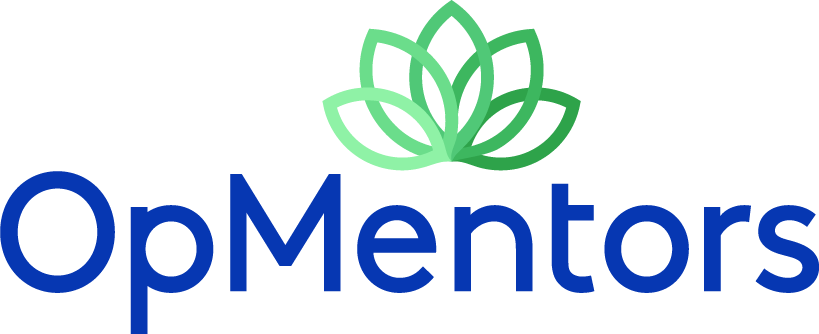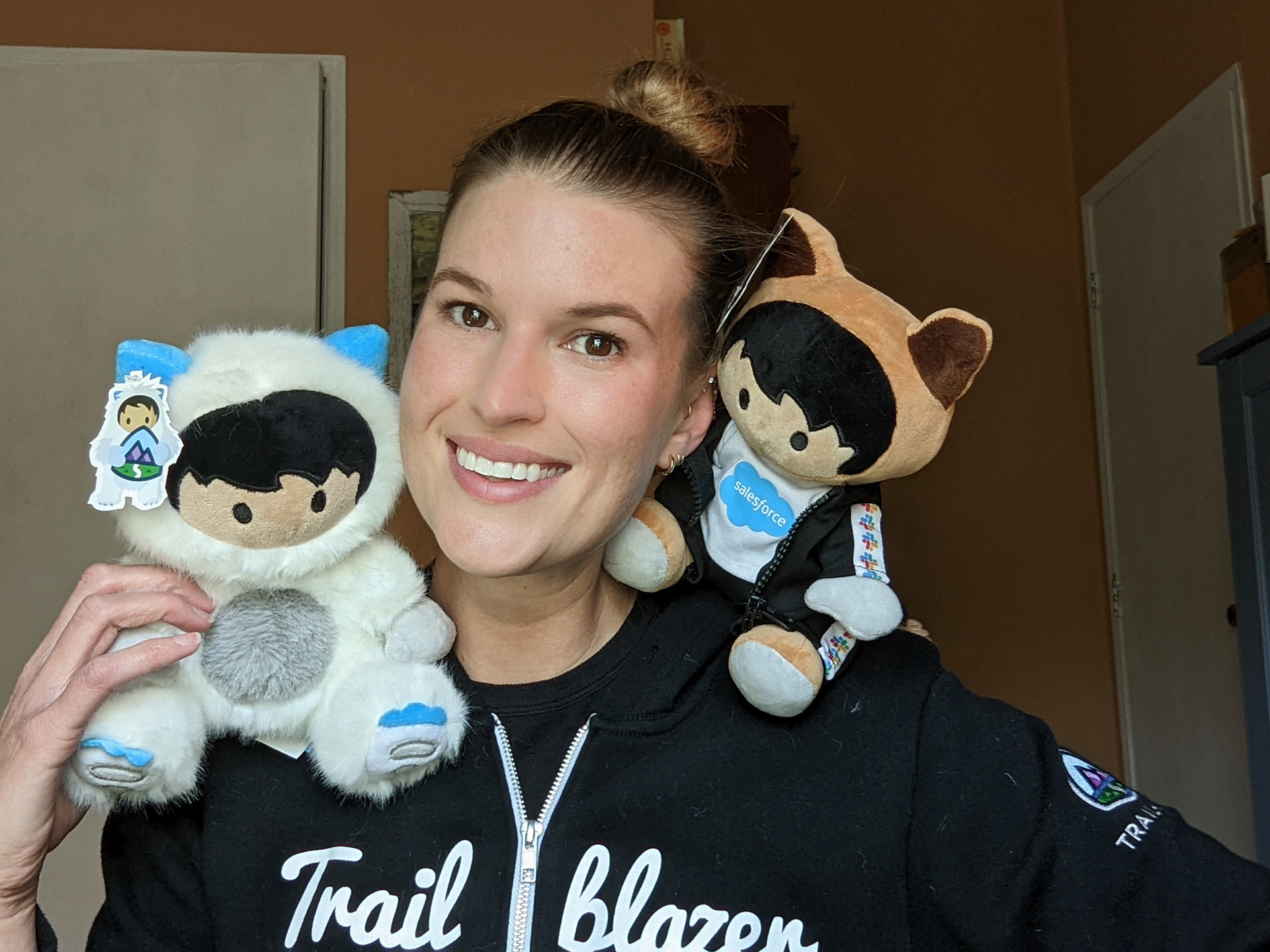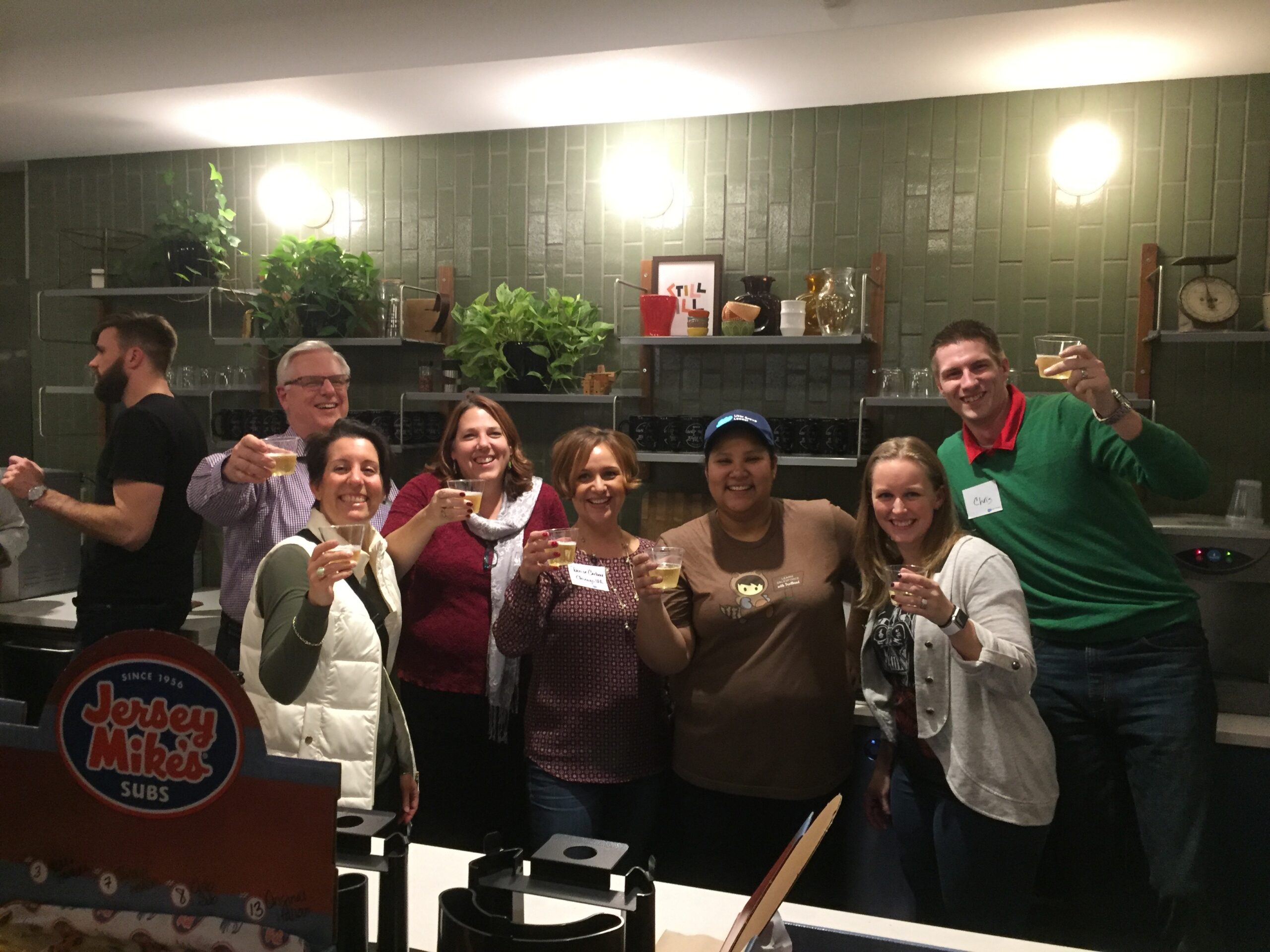10 Techniques to Skyrocket Salesforce Adoption
You’ve learned about Salesforce’s ability to transform your business and invested a lot of time and money into the platform—but how do you get others in your organization on board? How do you teach users how to take full advantage of the CRM and supporting applications?
Lucy Mazon at Salesforceben.com defines Salesforce adoption as a measure of “the extent to which users have incorporated Salesforce into their day-to-day tasks.”
Salesforce adoption within your organization is crucial if you want the most return on your investment.
How do you skyrocket Salesforce adoption?
At this year’s DevOps Dreamin’ conference Ian Gotts said, “User adoption starts at the requirements-gathering phase,” and we couldn’t agree more! To maximize Salesforce and its supporting applications, you must find out 1) what tasks your users are responsible for every day and 2) what’s needed for them to accomplish those tasks.
Today we’re sharing 10 techniques you can implement to speed up Salesforce adoption and get users excited about your new solution!
1. Identify your users.
Put together a list of user roles and associate every role with a person. Give them a proper name and a title. Then write out their primary tasks.
Drill into each role’s daily tasks. What can be automated? Are there any processes you currently document with tools like Microsoft Excel that you could bring to Salesforce as a business process?
Identifying users and their roles in the requirements-gathering phase will set a firm foundation for your Salesforce adoption.
2. Set up default fields.
Time is money. The less time your sales team spends on logging any data into Salesforce, the more activities they can do to get them to that million-dollar sale. At the same time, it is important to have your Salesforce data clean.
Take a closer look at the Salesforce fields. Are there any that can be set at a default value?
For example, most of the accounts your sales team logs are customers, but sometimes—very rarely, but it happens—you get a partner. In this instance, you will need to set up a default value and train your sales team to switch the account type file when necessary so they can report on it later.
3. Test your picklist fields.
Picklists are menus that expand to give users choices. Sometimes, these lists are too long because Salesforce administrators don’t think about the options end-users do and don’t need.
Take a look at your picklist fields and think about them from an end-user’s perspective. Try testing all of them. Does the end-user need all of the options available on the picklist? If not, remove the ones they don’t need.
4. Minimize the number of required fields.
Enthusiasm for user adoption will drop if a user is annoyed because they can’t save a record and instead is inundated with errors on the screen. In this instance, you need to decide which fields are vital to log your business.
Do you really need to require a customer’s birthdate on the Contact record? Or is it more important to require the email address that will be your primary way of communicating with the customer and may be tied to a new marketing campaign you’re planning?
Salespeople want to spend less time entering data and more time selling. Remember that next time you tell your Salesforce admin to require a new field.
5. Group common fields together.
Our brains like to group things so it’s logical to have similar items located in the same space on a Salesforce object!
Try grouping common fields into sections. User adoption will soar simply because users aren’t expending so much mental energy to associate items with one another—it’s done for them!
6. Add the “help” section to each custom field.
Some field names might be confusing to your users. Always try to add some helpful information to each new field you create. The help section should answer this question for your user: “Why and how do I need to fill this out?”
Another neat way to help end-users fully adopt Salesforce is to take advantage of Spekit, an application available on the Salesforce platform to educate and help guide users on a deeper level!
With Spekit, you can create “speks” for any object, field, or topic. Speks provide contextualized, in-app information about these components—examples include detailed definitions and explanations, training videos, and additional instructions.
If you feel like your users could benefit from some more in-depth guidance, ask us about how we can help you take advantage of Spekit!
7. Set clear expectations.
Managerial support is a powerful tool when it comes to user adoption. If a sales manager has a regular pipeline review with the team, there is no better way to run the call than by utilizing out-of-the-box tools already provided by Salesforce. Free dashboards for basic pipeline review come already pre-installed with every org. You can use them as a starting point and track team goals and progress.
You can also take advantage of Tasks and Activities in Salesforce to assign action items to team members and further track the status of the activity. You can configure them to fit your organization’s needs. For example, you can set up recurring events or reminders on Accounts, Contacts, and Opportunities. This is a great way to ensure your team is following up with prospects in a timely manner or doing their part on the team project.
8. Monitor user activity.
This point goes hand in hand with the previous one. Once you’ve decided what activities you’d like your sales team to log, track those activities in a weekly report.
Salesforce Labs also has a great Adoption dashboard that shows you the daily usage for the whole organization. It’s free and easy to download from the AppExchange.
9. Get user feedback.
We recommend that companies new to the Salesforce environment set up a weekly hour-long session with Salesforce admins and end-users called “Salesforce Wednesday.”
You can break this session into several parts: user training, new features, updates, Q&As, and some user feedback. Constant feedback is very important for Salesforce adoption and communicates to the end-users in your organization that you care about their experiences, challenges, and successes on the platform.
10. Develop Salesforce “power users.”
Salesforce “power users” are those users catching on fast! Identify the power users in your organization and start hosting advanced training sessions with them.
After you see that they’re confident making small changes in the system, create a specific profile set of permissions for them. You can assign additional permission sets for them so they’re able to manage reports and dashboards.
Power users are also great team members to test new releases or champion adoption among other end-users!
The success of Salesforce adoption among your users is a strong predictor of your return on investment in the solution and its supporting applications. We hope you’ll use these 10 techniques as a starting point for encouraging buy-in from your organization. What other techniques have worked for you? Let us know in the comments below!
At OpMentors, we’re passionate not only about helping you implement and optimize Salesforce in your business, but also about providing adoption support. Schedule a call today, and we’ll share more about how we help with adoption support so your organization can maximize its potential!
3 Key Upgrades from XL Loader to Datastream
XL Loader has served its purpose in the past for uploading tabular data to the Salesforce platform, but two major changes have recently deprecated the data uploading tool.
First, the need for a replacement was inevitable after Salesforce announced the company would require customers to enable Multi-Factor Authentication (MFA) to use Salesforce products and partner applications. (You can read more about this requirement here if you missed our blog post about it!) Second, Salesforce also recently made an API change, making XL Loader obsolete.
Effective May 1, 2022, you’ll no longer be able to use XL Loader to upload tabular data to the Salesforce platform.
However, FinancialForce introduced a replacement for XL Loader in October 2021, called Datastream, a tool for uploading tabular data with multiple headers and lines to the Salesforce platform.
Here’s why that’s a good thing, even if it requires some effort on your part to learn how to use a new tool. XL Loader wasn’t without its limitations since the plug-in was created for Microsoft Excel.
Datastream is a Lightning app embedded on FinancialForce, making it quick and easy to upload and create Financial Management records like journals, sales invoices, payable invoices, credit notes, and cash entries. Because Datastream is internal to FinancialForce Accounting, its functionality and security settings no longer rely on systems outside the Salesforce ecosystem, making it better, faster, and more secure for you when uploading spreadsheets!
Datastream is free for FinancialForce customers, and we love how easy it makes uploading spreadsheets. Even though it’s internal to the FinancialForce Accounting solution, Datastream will support any object on the Salesforce platform—even accounts and contacts! If you haven’t tried it, today we’re sharing 3 key upgrades from XL Loader you’ll experience when you install Datastream.
1. Datastream easily adapts to different operating systems and spreadsheets.
For a long time, FinancialForce users relied on XL Loader to upload data from a spreadsheet onto the Salesforce platform. Because XL Loader was a plugin for Excel, users like you were limited to Microsoft Excel if you wanted to transfer tabular data to the Salesforce platform.
Not anymore! Datastream is much more versatile. FinancialForce wanted to create an app that wasn’t dependent on a single source—Microsoft in this case—for data transfer. With Datastream, you can upload your data from any spreadsheet file, such as Microsoft Excel, Numbers, and Google Sheets.
Because Datastream lives within FinancialForce, the app is user-friendly for both Mac and Windows. XL Loader required an up-to-date version of Windows and Microsoft Office or a virtual workspace like Amazon Workspace or Parallels. You won’t have to worry about these requirements anymore with Datastream!
2. Datastream allows you to copy and paste multiple headers and lines at once.
You can say goodbye to slow uploading times for tabular documents that must be converted to CSV files first. With Datastream, you’re able to just copy and paste your data in the Lighting tab from any spreadsheet file. Because of this, the app can handle uploads with a higher volume of data at faster speeds than XL Loader.
You can also upload multiple headers and line items at one time, and Datastream will map the line items to their respective headers. Unlike XL Loader, you don’t need a separate mapping tool to link a column to its field in Salesforce—Datastream is “smart” enough to map them on its own! How? The column headers just need to be correct.
FinancialForce also has pre-designed templates available in the Community that you can modify to meet your individual business needs. Then you can easily make changes to your template without the hassle of manually mapping the fields again before you upload them.
Datastream uses the API name for the objects you’re uploading so make sure your source record includes them. You can find a list of these API names for FinancialForce Accounting on the templates available to you by logging into the FinancialForce Community and visiting the group called “FinancialForce Labs Datastream.” You can also find the API name by going to the object in Salesforce (Setup > Object Manager > Select Object > Details > API Name).
3. Datastream quickly catches errors before you upload tabular data.
A final step up from XL Loader is Datastream’s ability to catch errors before you begin uploading your spreadsheet to the Salesforce platform. If you used XL Loader, you’re familiar with the process of uploading a file, only to have the upload fail due to an error.
XL Loader also returned only the first error in a line, even if the line had multiple errors. Many times the returned error had a generic message like “Document has errors,” making it difficult to pinpoint the source of the problem.
When you copy and paste templated data into Datastream, the app returns any errors at that time—before you begin your upload! This makes it easier to correct any errors upfront and upload higher volumes of data at once.
After you’ve copied and pasted a table, a red box will appear if your table contains an error, and it will provide details for the error returned. You’ll just amend the data in the source table based on Datastream’s feedback, click the “Clear” button in Datastream to reset the workspace, and paste your revised data.
Once you’ve uploaded your data successfully, Datastream will provide a summary panel with the overall status of the upload. It will also give you detailed panels underneath with the individual objects you added or updated in the Salesforce platform.
Make sure you’re prepared for making the switch from XL Loader to Datastream by May 1. We appreciate the effort FinancialForce put into creating a replacement for XL Loader that is faster, more versatile, and more secure. Schedule a call today if you need help preparing for this change to take effect! Our mentors are always ready to walk alongside business leaders like you to help you get the most out of Salesforce, FinancialForce, and their supporting applications.
What Running and Salesforce Have in Common
OpMentors Associate Consultant Meghann Milligan took up running around the same time she dove into Salesforce.
She had no previous experience with running or Salesforce. Meghann admits she wasn’t technically inclined when she started learning about Salesforce—she got her bachelor’s degree in anthropology and classics! Previously a volleyball player, she wasn’t inclined to running as a hobby either. But she discovered a lot of crossover between both interests.
“To be successful at running and avoid unnecessary injuries,” Meghann explained, “you need to start gradually and build up strength and endurance.”
Learning the ropes of Salesforce was no different. Before Meghann discovered the power of the Salesforce platform, she owned her own business as a massage therapist. Later she took a course on data analytics while working as a client operations manager at a mental health clinic.
Then she learned about Trailhead, a free educational tool from Salesforce. She found a new passion—and a new career path—she wanted to pursue.
“I went from being a massage therapist that sold fancy soap to someone who builds organizations and plays with declarative coding to streamline processes,” Meghann said. “I really am a student at heart. I was always the kid asking, ‘WHY!?’ I like knowing how things work, why they work the way they do, and how to make it better. Once I started down the paths Trailhead, it really started to fire up the neurons.”
Meghann started gradually running—literally and metaphorically on Trailhead. She learned that being a successful runner and becoming a successful Salesforce consultant both require you to start small and build strength and endurance. If you’re unfamiliar with Trailhead, here’s how Meghann describes it:
Trailhead is a gamified learning platform, and by that I mean you complete “trails” and earn badges, and you reach different ranks based on how many badges you earn. The Trails are on all things Salesforce from “How to Be a SysAdmin” to “Learning APEX” and “UX/UI Design.” I think it's one of the most brilliant ways to bring people into an ecosystem who may or may not have that tech background… And as someone who loves learning (the ongoing joke in my family is that I would be a professional student if possible), this is an exciting “dream” platform. There's always something new to learn!
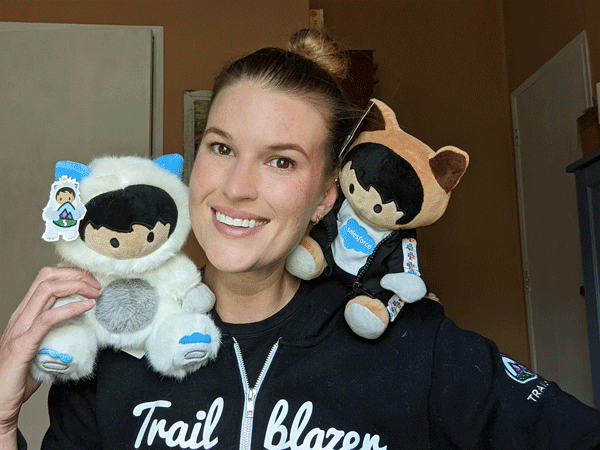
At the same time, Meghann began learning the foundations of running and Salesforce—and why they matter. She says understanding the foundations are important when dealing with compounded systems, whether you’re referring to the physical body or Salesforce platform!
“You’re in charge of complex systems in both of these instances,” she said. “When running, you need to focus on your form, your breathing, your foot placement, stretching your muscles, and hydration. In Salesforce, your focus is on object and user management, permissions, security, and clouds!”
Grasping the foundations are so important when learning your way around Salesforce, and Meghann wants to encourage readers just starting out to be patient with yourself.
“My boss tells me all the time, ‘Crawl. Walk. Run.’ I think it’s so easy to want to dive into the deep end,” she said. “Sometimes, you forget that knowing your security settings, profiles, and permissions—this is your bread and butter.”
Once you get a handle on the foundations of Trailhead and Salesforce, it’s important to also understand the “why” behind what you do on the platform.
“To be successful at Trailhead and Salesforce, you need to understand the core of CRM—the ‘why’ behind the Trail,” Meghann said. “Anyone can just click and blitz through the modules and earn those badges, but what have you retained?”
As you learn to solve complex problems, the “why” becomes important. Just like anyone can take up running, many different types of organizations, structures, and systems can take advantage of Salesforce because of its adaptability. However, the “why” is important for optimizing Salesforce so that it meets your unique needs. Meghann recommends Trailhead Superbadges to deepen your knowledge and understanding about how Salesforce works once you’ve got the basics:
I love the Superbadges, which are the best way to learn in my opinion. This outlines a problem you need to tackle. It doesn’t tell you how so it’s a great way to see what you’ve retained. I wish other people knew [Trailhead] is a guide. Eventually, when you get into the ecosystem (and, by this, I mean you land a Salesforce job), there are so many different ways to solve for X that you need to be able to open yourself up to the possibilities.
Now that she’s learned to crawl, walk, and then run on the Salesforce platform herself, Meghann loves to help OpMentors clients solve complex problems too. She hopes her journey encourages you to have patience with yourself while learning how to maximize Salesforce and FinancialForce in your own organization. She also says not to take yourself too seriously:
Even though it’s silly, WRITE IT DOWN when you learn something new. Six months from now you’ll look at a note and think about how adorable it is that at one point this was noteworthy… It takes time. Be patient with yourself. There’s no perfection, only progress. This is all applicable to running and Salesforce. I know it sounds like the worst platitudes, but they are all true. You are going to look foolish, and it’s so much easier if you can accept that you’re learning.
Meghann and the rest of our team at OpMentors are passionate about helping business leaders like you get the most out of Salesforce and FinancialForce. Want to learn more about how these solutions can adapt to meet the unique needs of your organization? Schedule a call today, and let’s talk about how our team can help you get started.
Our Top Reads for Building Your Business
Today is National Read Across America Day!
If you don’t know about the holiday, the National Education Association (NEA) established March 2 as National Read Across America Day to get students, teachers, parents, and communities excited about reading. March is National Read Across America Month so today officially kicks off a month-long celebration of the joy found in reading.
Our team at OpMentors loves to read. To celebrate the holiday, we’re sharing some of our favorite reads about building your business on topics from developing emotional intelligence to learning leadership principles and skills from Navy SEALs! After you finish reading, leave a comment and tell us your favorites too.
The Energy Bus: 10 Rules to Fuel Your Life, Work, and Team with Positive Energy by Jon Gordon**
Last week we wrote about how Jocelyn Fennewald and Machell Enke started OpMentors 8 years ago. They read The Energy Bus together, and it has had a lasting impact on the way they lead OpMentors today!
Through artful storytelling, Gordon shares 10 secrets to positive, forward thinking that lead to true accomplishment in your life and work. You’ll learn how to overcome common obstacles and bring out the best in yourself and your team.
Extreme Ownership: How U.S. Navy SEALs Lead by Jocko Willink and Leif Babin
Jocko Willink and Leif Babin led “the most highly decorated special operations unit of the Iraq War.” Now, they’re helping businesses from startups to Fortune 500 companies excel by teaching what they learned about leadership in combat.
Their book details the mindset and principles that helped their unit accomplish such difficult missions, and they demonstrate how you can apply them in your own business environment to lead your team well.
Give and Take: Why Helping Others Drives Our Success by Adam Grant
Resumes focus on individual achievements, talent, hard work, and passion. But we all know that true success is dependent on our interactions with others too, especially as business leaders.
With “cutting-edge evidence and captivating stories,” Adam Grant argues in Give and Take that most people are takers, matchers, or givers at work. Givers are those who serve others without expecting anything in return and achieve great success across a range of industries. Read his book to learn how to be a giver who drives success not only for you, but also for your team.
Start with Why: How Great Leaders Inspire Everyone to Take Action by Simon Sinek
Before Start with Why became a book, it was a TED Talk that reached 28 million people! Sinek argues that people have to understand why before they invest in anything, whether a product, service, movement, or idea.
Want to get buy-in, whether from employees, partners, or clients? Start with Why introduces a framework for your business that can explain why people with little in common like Martin Luther King, Jr., Steve Jobs, and the Wright Brothers were able to capture people’s attention and inspire them to action.
As a business leader, emotional Intelligence is crucial for leading a team and making decisions, but it’s often relegated to other characteristics like intellectual intelligence or a skill set.
Rego argues for the need to move it up on your priority list when building your business. Emotional intelligence “refers to identifying, evaluating, and managing one’s emotions.” Check out Rego’s book to grow in the emotional intelligence you need to lead your own team and look for it in others.
The Obstacle Is the Way: The Timeless Art of Turning Trials into Triumph by Ryan Holiday
Obstacle or advantage? Ryan Holiday argues in The Obstacle Is the Way that your problems can become your biggest advantages with the right perspective.
Holiday relies heavily on stoicism – “the ancient Greek philosophy of enduring pain or adversity with perseverance and resilience” – to demonstrate how people like Amelia Earhart, Ulysses S. Grant, and Steve Jobs turned “obstacles into opportunities.” This book’s for you if you’re looking for a fresh perspective on the obstacles you’ll encounter as you grow your business.
Many business leaders lead with requests and demands, but have you ever thought about leading with questions? Michael Marquardt says leaders start to see incredible results from their teams when they encourage questions and actively listen to their responses.
This book is both theoretical and practical. Marquardt offers “specific techniques of active listening and follow-up, and helps you understand how questions can improve the way you work with individuals, teams, and organizations.”
Traction: Get a Grip on Your Business by Gino Wickman
Does your business feel like constant chaos? We talk a lot about how digital solutions can help at OpMentors, but Traction addresses issues like personal conflict, profit deficits, and stagnant or insufficient growth.
In his book, Gino Wickman highlights 6 key components of any business and how you can strengthen them. You’ll learn practical ways to create a business culture of focus, growth, and enjoyment for you and your team!
Upstream: The Quest to Solve Problems before They Happen by Dan Heath
Desmond Tutu famously said, “There comes a point where we need to stop just pulling people out of the river. We need to go upstream and find out why they’re falling in.” You can say the same about problems in your business.
Many business leaders are constantly reacting to problems and putting out fires. What if you took a different approach and looked upstream to identify and fix the systems causing the issues? You’ll learn how to switch to an “upstream mindset” and be proactive in your business when you read Dan Heath’s book, Upstream.
Happy reading – and Happy National Read Across America Day! These favorites of ours have impacted how we measure and achieve success at OpMentors, especially since they emphasize the importance of relationships in building a business. These books have helped us better meet the needs of others, both internally in how we work with one another and externally in how we relate to our clients and other partners. We hope some titles caught your eye so you can add to your wish list too.
In your business, implementing and optimizing strong solutions is another way to prepare your team for success. That’s what we do best! Schedule a call today if you’d like to learn more about how OpMentors can help you get the most out of Salesforce, FinancialForce, and other supporting solutions.
**Throughout this blog post, we provide links for the books we recommend so you can easily find them. These are NOT affiliate links, and we don’t benefit monetarily or otherwise from the links we provide.
What Business Owners and Bus Drivers Have in Common
In 2013, our founders Jocelyn Fennewald and Machell Enke were in the audience at Dreamforce – a conference for Salesforce users – when a speaker asked this question:
“What would you do if you weren’t afraid?”

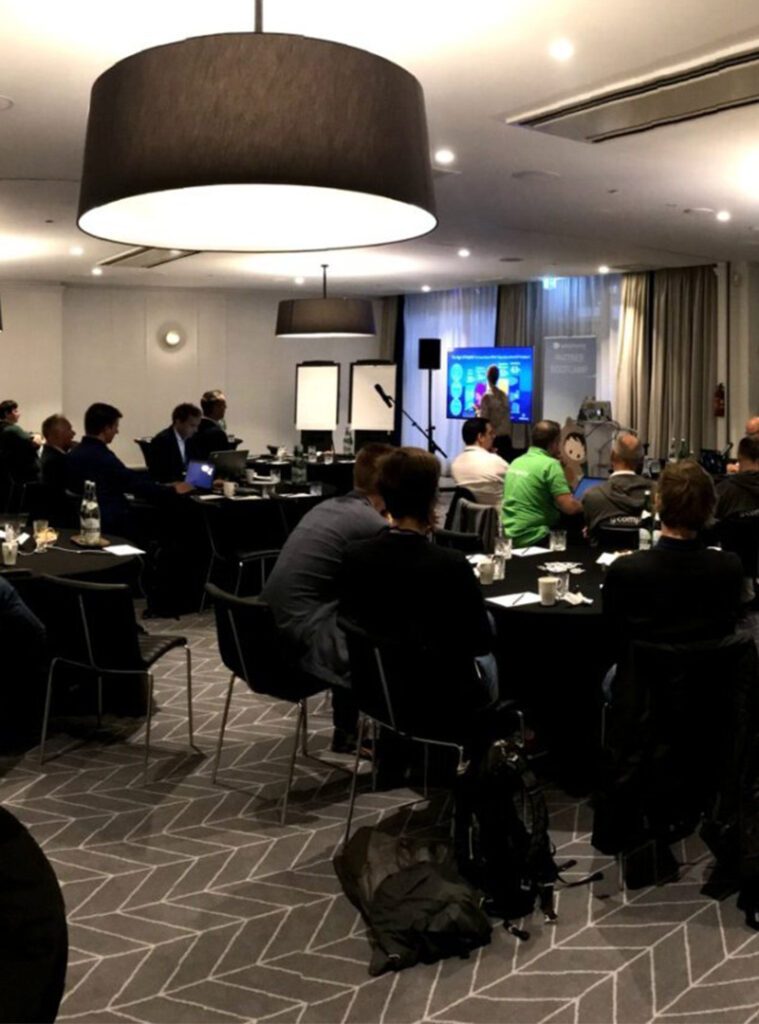

They wanted to share what they had learned with business leaders like you and help you take the guesswork out of Salesforce, FinancialForce, and supporting solutions.
On February 24, 2014, OpMentors became a company! But before there was OpMentors, there was Panera Bread…
Jocelyn and Machell met at Panera Bread one day, thought long and hard together about what they wanted to achieve, and crafted their vision and goals for the company. Eight years later they compare owning your own business to driving a bus. They use this analogy a lot when talking to others about what it takes to run a business.
How do you run your “bus” – or your business? In honor of our eighth anniversary, we're sharing with YOU what Machell and Jocelyn have learned along the way.
1. Find a partner you can trust.

By 2013 when they attended Dreamforce, Machell and Jocelyn had mastered Salesforce and FinancialForce in their own company, which went paperless with these powerful solutions (a big deal in 2013!) and grew in sales and revenue without scaling the back office.
Each knew the other partner had the knowledge, skillset, and passion to teach others about these solutions, but they also knew they could trust one another.
Trust is important, especially in a business partnership. Before you get on the bus and start a business, make sure you have a partner you can trust. You and your partner should also have a common destination for your journey and feel you both have the freedom to be honest about your goals and even disagree at times.
2. Have a “navigation system” in place.
When driving a bus, the driver needs a roadmap or navigation system. Business owners need one too!
You should find a business partner who’s not only trustworthy, but also shares your destination or vision. Jocelyn and Machell knew they wanted to be operational mentors focused on helping people maximize Salesforce and FinancialForce in their businesses. They shared the same destination.
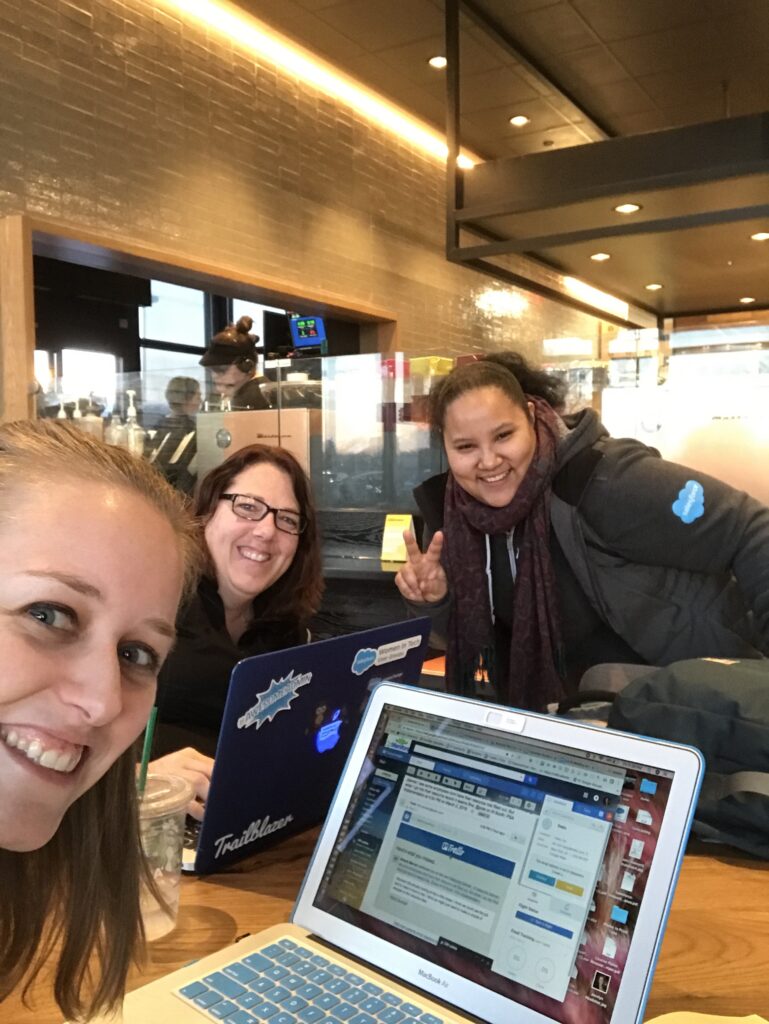
One way to ensure you’re driving in the same direction is to craft a mission statement. A mission statement is like a point on the horizon you’re driving towards. Since the beginning, OpMentors’ mission statement has always guided Machell and Jocelyn when making decisions to ensure they’re staying true to their core.
Another way to keep your mission statement in view is to brainstorm a company name that captures your mission. Machell and Jocelyn admit picking a name was probably the hardest part of starting a business.
They knew they wanted to be operational mentors. After discovering the dictionary definition of a mentor as “an experienced and trusted advisor,” Machell and Jocelyn decided on OpMentors. They wanted their clients – or the passengers on their bus – to know they’re on the journey with OpMentors to the same destination of success.
As a business owner, a good “navigation system” will also include trusted advisors, mentors, or coaches. Machell and Jocelyn had a business coach for several years to help them become better leaders and drive the company’s vision forward.
3. At every bus stop, determine the right people to join you.
Like passengers on a bus, partners on your business journey come in all shapes and sizes. Passengers aren’t limited to clients and employees – they include other strategic partners, mentors, and even family members. All of them play important roles in achieving your mission.
When starting a business, Machell and Jocelyn recommend picking up these passengers first: an accountant or tax advisor, investment planner, your spouse or significant other, family members, and friends. You also need a good system for getting a holistic view of your business – like Salesforce and FinancialForce, of course!
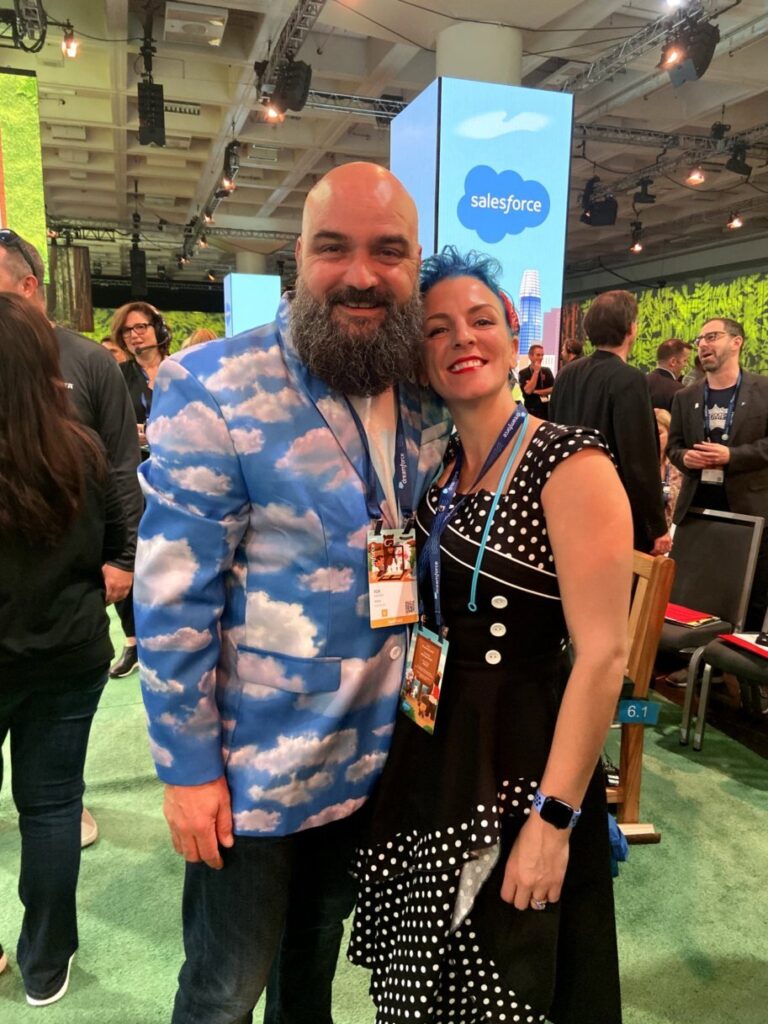
Then you can look for employees and clients to grow your business. When Machell and Jocelyn began, they were the drivers, mechanics, and maintenance crew of their own bus.
You don’t have to do it all by yourself! Utilize others’ skill sets. Decide which employees you should hire first. Weigh the pros and cons of using strategic partners for certain responsibilities. Utilize networks like WITness Success or Trailblazer Community and events to help you find the right passengers. Hire others to help you create your website or market your company.
Last but not least of your passengers are your clients. Some will work with you for a short time, and others will stay on your bus for a while.
Each client has their own expectations and final destination of the journey in mind so practice active listening to assure them you understand their goals while clearly communicating your own goals and expectations for the ride. Expect to learn something from your clients too!
4. Prepare for growth (and surprises!) along the way.
As you scale your business, you’ll want to set realistic goals for success. Continue to build strategic partnerships and diversify your offerings when possible.
You’ll also want to consider the knowns and unknowns of your business. What can you plan with certainty, and what remains an X factor?
If you drive a bus long enough, you will inevitably come across some surprises or bumps in the road. Be encouraged: there are other routes to reach your destination. Finding them just requires some flexibility and creativity!
Discuss alternative routes with your business partner and remember not to take yourself too seriously – eating ice cream and laughing along the way are perfectly acceptable on your bus.
You’ll hear entrepreneurs talk a lot about the trials of starting a business, but you also need 3 G’s – grit, grace, and gratitude – for the journey. Machell and Jocelyn are proud to have grown a company that can play a significant role in others’ journeys too. We hope the lessons they’ve learned are helpful and encouraging to you as a business leader charting your own course.
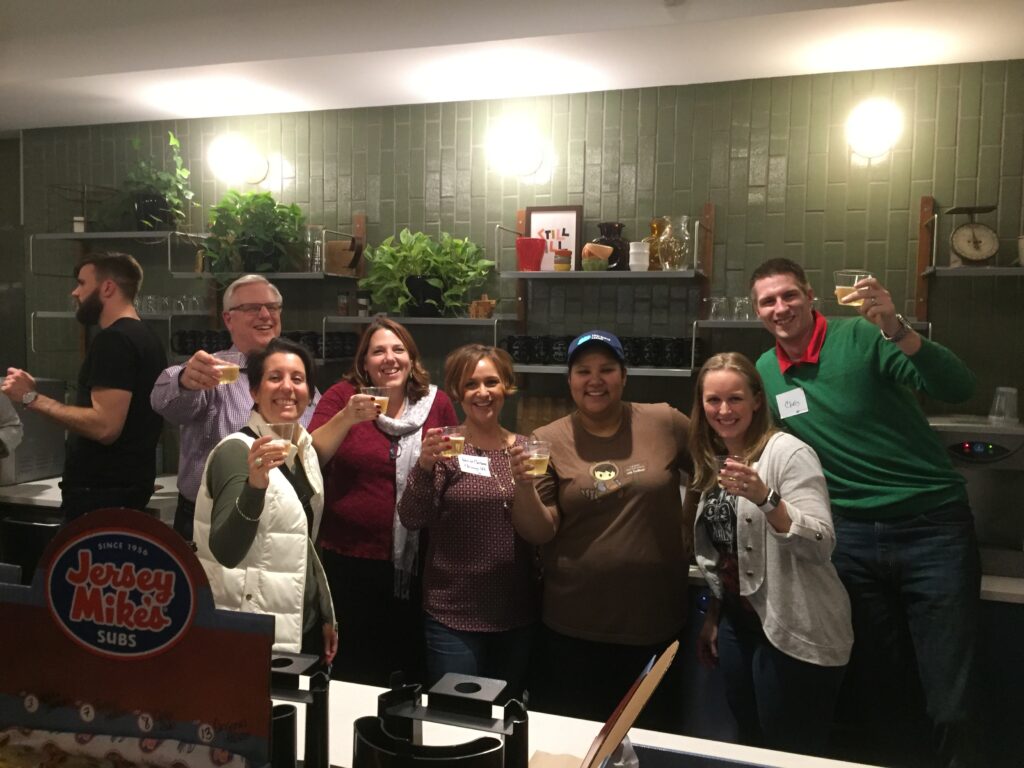
If you’re ready to utilize Salesforce or FinancialForce in your business journey, our team at OpMentors can help! We recognize that every business is different and take a consultative approach to your solutions so they meet your unique needs. Schedule a call today, and let’s talk about how OpMentors can help you pursue your mission.
Love Year-Round: How Kurandza Shows Love through Education
OpMentors is celebrating Valentine’s Day a bit differently this year. We want to express our gratitude for organizations showing love and impacting the world on a daily basis.
If that’s you, our team is thankful for the work you do!
One organization near to our heart is Kurandza. If you’ve not heard of it, this week we want to introduce you to Kurandza’s founder, Elisabetta Colabianchi (pictured on the far left below), and the amazing work the organization does to ensure more girls around the world get the education they need.

Based in Mozambique, the grassroots nonprofit’s name means “to love” in Changana, the local language of the villages where Kurandza works. We asked Elisabetta why they chose the name. She said the name honored both the local culture and the organization’s core value.
“We chose ‘Kurandza’ as the name of our organization because love is our top value and what fuels our work!” she said. “We strive to pour love into everything we do and everyone we work with – from the girls in our education programs and the women on the team to our amazing partners.”

In 2014 (coincidentally the year OpMentors was founded!), Kurandza began as a sewing cooperative, equipping Mozambican women with knowledge about financial literacy, health, and entrepreneurship. Over the years, Elisabetta and the rest of the team’s focus shifted to education. They realized that the difference education can make in a young girl’s life and the trajectory of her future is invaluable.
In 2017, they launched the first #IStandForGirls campaign with the goal to send 100 girls to school. Since then, Kurandza has been equipping girls with the education and mentorship they need to become leaders in their communities.
Kurandza’s approach is holistic. The team has “focused our efforts on providing scholarships, resources, and psychological support to the now 250 girls in our program.” Elisabetta said they make sure love is the motivator for all they do, and this has made a big difference in their relationship with the girls they serve.
“We care for the girls holistically, from start to finish of their schooling (and even once they graduate),” said Elisabetta, “and the girls have seen this firsthand and trust us. They feel cared for and loved by our entire team and the many donors and partners around the world. This translates into increased confidence, self-respect, and courage.”

Elisabetta lives in California and runs Kurandza stateside. She primarily oversees operations, develops programming, and communicates with donors and supporters to ensure girls in Mozambique receive the education they need to succeed. However, the day-to-day operations are primarily led by women in the local community in Mozambique, according to Kurandza’s website:
As a grassroots organization, Kurandza has deep roots in the community and much of our leadership team is the 1% of Mozambican women who go on to complete a college education. They serve as a powerful example and true embodiment of the difference schooling can make in one’s life. Our hope is that this will inspire the girls in our program to see the possibilities and, in turn, dream of a brighter future for themselves.
Elisabetta said the daily commitment these female leaders make to serve others and put others’ needs above their own is how Kurandza shows love through action.

“It is easy to clock out when the work day is done or do what’s required and nothing more,” Elisabetta said. “However, we strive to go above and beyond, going the extra mile for the girls, donors, and fellow team members. It’s important to us to do an exceptional job and that everyone we come into contact with feels heard, seen, and appreciated.”
Elisabetta said spending time in Mozambique has changed the way she thinks about love. The kindness and hospitality among Mozambicans has shown her that love is often displayed most through “simple actions that put others above ourselves” – things like serving a warm meal to an unplanned visitor, traveling out of your way with someone to make sure they get where they’re going, or stopping an important task to help a friend.
When asked how Elisabetta might encourage our readers to love others this year, Mozambique’s influence is evident in her response:
“Love is kind, and showing random acts of kindness to strangers is a fulfilling and impactful way to show love,” she said. “You could pay for a stranger’s lunch or coffee, add coins to expired meters, smile and say hello to someone on the street, [or] let someone go ahead of you in line. There are so many simple things you could do to be kind and show love to someone you don’t know!”
What’s on the horizon for Kurandza in 2022? The organization is working to break ground on a new learning center in Mozambique, create an alumni program for their first Kurandza graduates, and get to know their community of partners better. You can learn more about their goals this year and the milestones they achieved in 2021 here.
If you want to support Kurandza, Elisabetta said the best way to do so is to donate to their mission here. Another simple way to support their mission is to educate yourself and others about the statistics and impact that education can have on girls across the world (especially those in rural communities!) and spread the word about the impact Kurandza is making.

Elisabetta would also love for you to check out their Instagram page to stay informed about their initiatives and learn more about the impact Kurandza is making and the love they are showing on a daily basis!
This Valentine’s Day we celebrate the love Kurandza is showing in Mozambique every day as they equip girls with the education they need to thrive and lead. We encourage you to learn more about the different ways you can support Kurandza’s work.
What You Need to Know about Salesforce's MFA Requirement
Yesterday Salesforce began requiring customers to enable Multi-Factor Authentication (MFA) to use Salesforce products and partner applications, including FinancialForce.
Take a deep breath if you haven’t implemented MFA yet – you won’t be barred from your Salesforce account.
You still have time to enable MFA if your users aren’t ready, but Salesforce will begin enforcing this requirement by automatically enabling the feature so that Salesforce administrators can easily enable this feature for users.
You’re not alone if you’re overwhelmed and inundated with information about this additional level of security to your solutions. On our blog today, we’re answering some questions we’re commonly asked about Salesforce’s MFA requirement and what you can expect in the coming months.
What is MFA?
MFA stands for “multi-factor authentication.” Salesforce explains it best:
MFA is an effective way to increase protection for user accounts against common threats like phishing attacks, credential stuffing, and account takeovers. It adds another layer of security to your login process by requiring users to enter two or more pieces of evidence — or factors — to prove they’re who they say they are. One factor is something the user knows, such as their username and password combination. Other factors are verification methods that the user has in their possession, such as an authenticator app or security key.
Salesforce prioritizes trust and takes security seriously. Businesses face a growing number of threats to their data for several reasons, including the globalization of information and increase in remote work. Requiring two or more factors from users improves login security and safeguards against attacks that can compromise the data of your business and customers.
If the concept of MFA is unclear to you, Salesforce’s comparison to your debit card is helpful: “A familiar example of MFA at work is the two factors needed to withdraw money from an ATM. Your ATM card is something that you have and your PIN is something you know.”
When users are required to log in with two pieces of evidence instead of one, the chances of an attacker being able to guess or hack both of them is dramatically lower.
What’s Next?
According to Salesforce, “internal users who log in to Salesforce products (including partner solutions) through the user interface must use MFA” as of yesterday, February 1. This means that Salesforce is contractually requiring your company to implement MFA for all its users. You can enable MFA directly in your Salesforce products, and the functionality is available at no cost to you.
If you haven’t enabled MFA, you have some time, but Salesforce will begin automatically enabling MFA for users who log into Salesforce products. (You will receive a minimum of 6 months notice via email before MFA is enforced in your Salesforce products.) Salesforce has a good plan in place for implementing MFA here. If you need assistance with MFA rollouts, our mentors are here to help too!
Salesforce is also very transparent with planned dates for enforced MFA rollout when MFA will be a mandatory requirement for all users. The MFA Enforcement Roadmap here is Salesforce’s public page detailing this process and provides auto-enablement and enforcement dates for each product so you can plan ahead if you haven’t already.
What Verification Methods Are Available?
Maybe you understand the comparison between MFA and your debit card, but you’re wondering what the extra authentication step will be for Salesforce users.
Salesforce has created the Salesforce Authenticator App, a free mobile app that makes logging in with MFA quick and easy. They’re encouraging users to download this app for additional verification. To learn more, you can watch a short video about the app here.
But you can also use a third-party authenticator app, security key, or built-in authenticator.
Salesforce has provided a great guide here for admins if you want to learn more about these verification methods and weigh the pros and cons of each. The guide also details instructions about how to implement MFA and roll it out to your Salesforce users.
It’s okay if you still need to implement MFA for some or all of your Salesforce products and partner applications. To recap, here are some helpful resources we’ve linked throughout the article and others we didn’t:
- Salesforce Multi-Factor Authentication FAQ
- Multi-Factor Authentication Quick Guide for Admins
- How to Use Salesforce Authenticator for MFA Logins (video)
- MFA Enforcement Roadmap
- MFA Requirement: What’s Top of Mind for Salesforce Trailblazers
- How to Roll Out Multi-Factor Authentication
- MFA - Getting Started (Trailhead Group)
We hope this information and the resources provided clarify any confusion about adding MFA to your Salesforce products. If you have any questions, please ask them by commenting below, and one of our mentors will respond!
Our team is always here to help you get the most out of your solutions and ensure they’re secure. Schedule a call today to learn more about how to maximize Salesforce, FinancialForce, and other supporting applications in your business.
4 Marks of a Great Project Manager (and How to Become One!)
If you work in a company with deliverables requiring project management, you know how pertinent a project manager is to the success of your project.
A great project manager is more than a taskmaster. They must see the big picture and minute details of a project’s execution. They also oversee internal communication between teammates and external communication with clients.
That’s a lot of responsibility!
Let’s establish a shared definition of project management. Toggl Plan defines project management as “the process by which a project is planned, tracked, controlled, and reported.”
Project managers are those on your team responsible for this process. They plan and execute the project with a team.
At OpMentors, we couldn’t help our clients maximize their solutions without the excellent work of our project managers. We’ve noticed some marks common among great project managers, and today we’re sharing them with you.
Here’s the good news: anyone can grow in these areas if you’re willing to learn!
1. A great project manager is a servant leader.
Great project managers are what we call “servant leaders.” Dave Russell, one of our project managers at OpMentors, describes a servant leader this way: “A servant leader puts the needs of the team ahead of their own. Their primary goal is to enable the success of the team by ensuring they have everything they need and removing impediments that stand in the way.”
Being a servant leader is crucial to the success of any project because, as a project manager, you’re responsible for assigning tasks, setting deadlines, and communicating between your team and the client.
Think of yourself as a team advocate.
What does servant leadership look like in practice? Here are a few ideas.
First, When planning the execution of a project, you’ll want to confirm your team’s bandwidth for the project to make sure deadlines are realistic.
Second, you’ll want to make sure team members have everything they need to complete the project from you and the client.
Third, practice active listening. Active listening is “the ability to focus completely on a speaker, understand their message, comprehend the information and respond thoughtfully.” Active listening encourages team members to collaborate and speak up when a project hits a snag.
One practical way to make sure you’re actively listening to team members is to repeat back what they’ve told you and ask if you’ve understood them correctly. This helps you respond in a way that serves those you oversee.
2. A great project manager can see the big picture and manage small details.
In a single word, project managers must be organized.
Project managers oftentimes are managing multiple projects at once, and strong project managers will execute all of them within a given time, scope, and budget. To achieve those goals, they must be able to see the big picture of a project while giving special care and attention to the details.
The way a project manager plans and executes a project will vary by company and industry. But you should have a process by which you divide your project’s roadmap into phases. Each phase will have its own deadline when you’ll deliver something concrete to the client. Once team members have confirmed these deadlines, everyone should make every effort to meet that deadline.
How a project will be executed is just as important as who will do what and when.
Evaluate your current processes and see where they can improve. Then normalize your team’s methodology and tools as much as possible across projects so the big picture and details of a project remain intact. To accomplish this, our team utilizes FinancialForce PSA, a project manager’s best friend! Our project managers and FinancialForce PSA combined ultimately drive the success of OpMentors projects.
When a project does go off course, here’s a good plan of attack:
- Halt work on the project.
- Identify the root cause(s).
- Review the project’s original objectives and documentation.
- Update current activities and deadlines based on your findings with approval from your teammates and client.
- Restart the project with changes in place to ensure success.
A project has a great chance for success when a project manager creates a plan and executes it with streamlined processes and excellent tools.
3. A great project manager develops strong communication skills.
We intentionally used the word “develops” here instead of “has.”
That’s because strong communication skills are not inborn. Great project managers are always learning how to improve their communication skills.
We already mentioned active listening to effectively communicate with team members. Creating agendas for meetings is another way to communicate well and serve those you lead. Agendas provide a plan for productive collaboration when projects are on track and when they aren’t.
OpMentors Project Manager Kelsey Gibson, said, “I try to ensure the meetings I’m having with the team have an agenda, and we’re actively discussing what challenges we see coming while strategizing for current issue resolution. Keeping everything visible and top of mind when it comes to potential challenges is helpful.”
Make sure everyone also knows their role in the big picture and small details of a project’s execution. You’d be surprised how many many employees feel they don’t know exactly what their responsibilities are. If team members don’t know your expectations, they’re probably frazzled and stressed, and you’re frustrated because you’re not getting what you need from them.
Overcommunicate. Then foster an environment where teammates feel they can ask clarifying questions if needed.
Lastly, great communication requires healthy conflict. No one likes conflict, but conflict-avoidant teams don’t make progress on projects.
Kelsey offered her advice on healthy conflict to project managers: “Learn to have thick skin. You’re steering the ship. If a teammate puts a hole in the ship, you’re responsible for it. Pro tip: come to the meeting about the hole in the ship with a patch and a resolution.”
Whether internally with teammates or externally with clients, address problems head on with transparency and honesty.
4. Great project managers bring a spirit of trust and encouragement to the team.
Employees usually don’t like to be micromanaged.
Great project managers understand team members need a balance between autonomy and oversight.
Team members need enough oversight so they stick to the project’s plan of execution. But they also need enough autonomy so they don’t feel micromanaged. When you as a project manager micromanage, team members can feel like you don’t trust them and their ability to do their part.
However, you bring a spirit of trust and confidence to the team when you find this balance as a leader.
Great project managers also recognize the good work their team does.
It’s easy to criticize. Team members will take note when you praise them for their efforts. Your team will work harder when you recognize what they get right — not just what they get wrong.
Consider ways to celebrate with your team too when you hit milestones on a project’s roadmap. Milestones are deadlines for each phase of a project. Come up with creative ways to celebrate your team’s success and recognize their contributions.
As a project manager, you’ll boost team morale when you bring a spirit of trust and encouragement to the office. You’ll never know the impact it might have on a person too.
Project management is a hard job, but these characteristics are great aspirations for project managers seeking to learn and grow. Our team at OpMentors can also help if you’re looking to improve your processes for planning, tracking, controlling, and reporting your team’s projects. Schedule a call today, and let’s talk about how FinancialForce and Salesforce provide solutions for your project management needs.
3 Successful Alternatives to New Year's Resolutions
A new year means new resolutions for most people, but you know the statistic: around 80 percent of all New Year’s resolutions fail by mid-February. Your resolutions in the past might have contributed to this percentage. But don’t give up on setting goals for the new year just yet.
Many people don’t achieve their resolutions because they’re overambitious without a clearly-defined plan. Other people struggle to push past the resistance they inevitably face when trying to reach a goal.
We believe there are more successful, sustainable approaches to goal-setting for the new year. Today we’re sharing 3 tips for setting achievable goals in 2022.
Then we’ll share our method with you for reaching our goals as a team. This method is easily adapted for individual goal-setting too!
Let’s start with some tips:
1. Create habits instead of resolutions.
Willpower and motivation are unreliable drivers for achieving New Year’s resolutions, according to Dr. B.J. Fogg, a social scientist at Stanford University and author of Tiny Habits.
Why? Because willpower and motivation fluctuate, depending on the day or circumstance. That’s why many people forego their New Year’s resolutions by mid-February. Emotions like passion, gratitude, and compassion are more likely to sustain a habit or resolution.
Still, Fogg suggests creating “tiny habits” instead of big resolutions because you’re more likely to achieve them. Plus, tiny habits lead to bigger ones, which people usually call “resolutions” anyway.
For instance, if you’d like to run a half marathon in 2022, create a tiny habit to work towards that goal. Be sure to personalize this habit so that it is specific to you and where you are starting from. Then focus on that habit at the beginning of the year. In an interview with CNN, Fogg gave 3 criteria for creating a successful habit:
Number one: It needs to be effective. Take meditation as stress reduction. For a lot of people meditation is not effective for reducing stress because all they do is become aware of how scattered their mind is, so that's a bad idea for those people.
For me, what's effective is going out into nature. Even a short little walk to the ocean or a short walk into the garden is very effective.
Number two: It needs to be a behavior people want to do. If you don't want to do that behavior, maybe you can manipulate yourself into it a few times but it won't become a habit.
Number three: It needs to be a behavior you can do. So I talked about walking out and looking at the ocean or looking at tadpoles. Well, I live in a place I can do that.
Your likelihood of success exponentially increases if your new tiny habit meets those three criteria.
2. Rethink how you define progress.
Usually, people think of progress and perfectionism as interchangeable. Their inner voice sounds something like, “My only measure of success is whether I perfect this resolution!”
But other measures of success exist besides perfection. Adam Grant is an organizational psychologist at the Wharton School of the University of Pennsylvania. He said, “Lower your standards for what counts as progress and you will be less paralyzed by perfectionism.”
You do not have to sacrifice excellence to “lower your standards.” This simply means you set realistic goals, timelines, and expectations of yourself.
Grant also tweeted, “An ambitious goal raises your odds of success [but] also boosts your odds of feeling like a failure.”
His solution? “...set 2 targets: an inspirational goal and an acceptable result. If you fall short of the aspirational goal but hit the acceptable one, you haven’t failed.”
Can you break your “big” resolution into tiny habits or small acceptable goals that you meet to measure your success? What quarterly, monthly, and daily benchmarks can you set and achieve? Have you taken stock of your physical, mental, and emotional bandwidth in the new year to ensure you have realistic expectations of yourself?
Set yourself up for success in 2022 by answering these questions and then adjusting your expectations accordingly.
3. Make sure you have “white space” in your calendar and your mind.
Rest is productive. That might sound counterintuitive, but prioritizing rest in 2022 will make you more productive, not less.
When we rest, we reap many benefits like optimal wellbeing, reduced stress, improved decision-making, and increased creativity and productivity. Companies are even experimenting with decreases in their workweek and finding that employees are more productive.
If you want to achieve your goals in 2022, then you’ll also want to add one more goal: rest more.
To make time for rest, first you’ll want to create some “white space” in your calendar.
This kind of white space is necessary for two reasons. First, think about how many times during your day something “comes up.” When you don’t have built-in margin for surprises, the first blocks of time you’ll nix are the ones for rest or those tiny habits that are important to you.
Second, you need white space for restful activities. Rest doesn’t always look like taking a nap –although it can! Restful activities are ones that restore the energy, joy, and peace you need to achieve your goals. This looks different for everyone so don’t forget personalization here too.
Next, you’ll want to create some “white space” in your mind. This is a harder concept to grasp, but our minds need white space like our calendars.
What makes your mind feel crowded?
For example, when you’re working on one task, are you always thinking about the next task on your to-do list? Try focusing on the one at hand until you complete it.
Do you feel like you can’t turn your mind “off” because you’re consuming a lot of information from social media, news outlets, or podcasts? Set some boundaries on these activities.
Have a running to-do list in your head? Try doing a “brain dump” every morning where you write down your mental to-do list so it’s stored somewhere else.
Do you have a hard time leaving work at work? Find a restful activity you enjoy and do at the end of your workday – even if it’s stopping by your favorite coffee shop on the way home – so your mind is able to make the transition from work to rest.
With some white space in your calendar and your mind, you’ll tackle your habits and goals with less resistance.
How OpMentors Sets Achievable Goals
“SMART” is an acronym commonly used for goal-setting. You can learn more about the history of this method for goal setting here.
At OpMentors, we use this method to set annual goals, and we’ve found it’s more sustainable than radical resolutions that fizzle out by mid-February every year.
Each letter in the acronym describes a feature of a SMART goal. SMART goals are:
- Specific (S) - Your goals should be narrow for more effective planning.
- Measurable (M) - You should define what evidence will prove you’re making progress on your goal and reevaluate when necessary.
- Attainable (A) - You should make sure you can reasonably accomplish your goal within a certain time frame.
- Relevant (R) - Your goals should align with your values and long-term objectives.
- Time-based (T) - You should set a realistic, ambitious end-date for task prioritization and motivation.
For the new year, you can use this method on your own or with your team.
Here’s how it works for us. At the beginning of the year, we always create SMART goals with our managers. Then we use these goals during quarterly reviews to assess our progress individually and collectively.
Throughout the year, we use the SMART goals to guide conversations about areas where we can improve. If we aren’t accomplishing certain goals within a designated time frame, we focus on the “why” to get to the root cause, remove any roadblocks to success, and reevaluate the components of our SMART goals.
Not only are SMART goals more attainable for our team, but they also give us a means to encourage and support one another. We never feel we’re trying to achieve our goals alone.
Happy New Year from our team at OpMentors! We know resolutions can be overwhelming. We believe you’ll be more successful with these alternative ways of thinking about resolutions or goals in mind.
Do you have some business goals you want to achieve in 2022? Schedule a call today to learn how OpMentors can help you reach them with solutions optimized for your specific business needs.
4 Ways to Engage Teammates when You’re Remote
Remote work was already on the rise before the pandemic began. While some companies have returned to their offices, others have decided to remain mostly or entirely remote.
Writers Anne Helen Petersen and Charlie Warzel interviewed many remote workers for their forthcoming book Out of Office, which speaks to this very topic. When intentional practices to cultivate camaraderie weren’t in place, Petersen and Warzel said many employees, especially those beginning their careers during the pandemic, felt disconnected from their supervisors and coworkers.
In an article last month for the New York Times, Petersen and Warzel wrote, “All were grateful to be employed, but many felt left behind, invisible and, in some cases, unsure about how to actually do their jobs.”
The OpMentors team worked remotely long before the pandemic occurred and “remote work” was a buzzword.In fact, we’ve been remote since our inception in 2014! . Working remotely has its benefits, but we’ll be the first to admit it also has its challenges.
Over the 8 years we have been remote, we’ve discovered some vital practices for our team so no one feels left behind, invisible, or unsure about their roles and responsibilities. Today we’re sharing 4 ways you can build camaraderie and cohesion among your remote team too.
1. Slack, Slack, and more Slack.
No, we’re not talking about slacking on your job. Slack is the perfect platform for remote teammates to communicate with one another. We’re big fans at OpMentors.
Lengthy email threads are cumbersome and confusing, especially those “Reply all” emails. At OpMentors, we’ve worked hard to find a better way to discuss opportunities, projects, and company announcements.
We rely on Slack a lot because the platform has organized spaces for communication called “channels.” We create channels for all of our opportunities and projects, which keeps communication in one place and eliminates a lot of back-and-forth and lost communication that many companies experience.
We also use Slack to collaborate with other companies! We often invite FinancialForce and Salesforce partners to join opportunity channels or subcontractors to join our project channels.
Slack gives everyone on our team control over how and when they get messages too. If teammates need to work “heads down” for a while, they can silence all notifications. They can also customize their settings so they only receive notifications on certain projects if they need to focus but they’re waiting for an urgent response.
Salesforce also owns Slack — an added bonus! Slack integrates seamlessly with Salesforce and can live on the Salesforce platform.
Check out Slack for your remote team if you haven’t already – it’s a great go-to for external and internal communication!
2. Have strong solutions in place for your (virtual) front and back offices.
We talk a lot about the importance of having a holistic view of your company. Even for employees who work in an office together, business can feel like chaos if different departments are working in isolation or entering data into disconnected spreadsheets or solutions.
That feeling intensifies for remote workers if you can’t view the status of an opportunity or project, confidently resource a project once an opportunity is closed, or make decisions about the company’s future without comprehensive analytics — and those are only a few pain points you might be experiencing!
We admit we’re biased. But we believe Salesforce and FinancialForce are powerful solutions to these problems, especially for remote teams.
Our remote team is always teaching others how they can maximize these solutions, but we like to say we “drink our own champagne.” We use Salesforce and FinancialForce to ensure our virtual front and back offices are communicating, even across thousands of miles.
We can’t stress enough the importance of having good solutions in place as a remote team, whether you use Salesforce and FinancialForce or not.
3. Be clear about expectations and have check-ins for accountability.
You might be surprised how many employees feel they don’t know the expectations their supervisors have of them. This problem can worsen for remote workers when they aren’t seeing and talking to their supervisor or teammates every day.
Do team members really know what’s expected of them?
One way to show you care for your remote team is to make sure everyone knows their roles and responsibilities. Then create a strong system of “checks and balances” to monitor whether they’re meeting your expectations.
We’re not encouraging you to micromanage your team. Micromanagement can lead to frustration and mistrust.
Instead, provide a good balance of accountability, freedom, and flexibility. Have clear expectations and measurables for the company as a whole. Then prioritize check-ins with individuals so they’re empowered to creatively meet their goals in a way and at a pace that works for them.
You can also have discussions or workshops with your team about ways to be productive at home. Working from home isn’t for the faint of heart, and it’s easy to get distracted. Encourage team members to set weekly and daily personal goals or practice time-blocking to decide ahead what projects they will work on and when.
Remote teams thrive when everyone knows what they expect from themselves and each other.
4. Keep work fun!
Jennifer Moss, author of Unlocking Happiness at Work, says, “...community and friendships are important — they can be the difference between loving or hating work.”
We believe she’s right, but building community can be difficult for remote teams. Only meeting to talk about business can lead to burnout.
We work hard to cultivate fun, community, and friendship at OpMentors. We foster a culture of work-appropriate humor. We encourage one another to have fun and not take themselves too seriously in team meetings and over Slack. Using gifs and emojis to express ourselves might as well be company policy! We also prioritize meetings to connect with coworkers on a personal level.
We celebrate together too! We make sure to recognize birthdays, work anniversaries, and other noteworthy milestones. We even have a “Kudos” Slack channel where we share positive feedback from each other and our clients.
How can you keep work fun for your team?
We’d also encourage you not to think of meetings only for accomplishing agendas. Some people work better around others, which you can surprisingly simulate virtually too. Create a virtual meeting room occasionally where teammates can pop in and work with one another.
Nik Panter, our Delivery Director you met last week, will open a meeting room and play music in the background so teammates can join him and work or chat as needed. It’s his virtual spin on “keeping his office door open.”
Remote teammates can sometimes feel they’re on an island. Get creative about ways to cultivate community from miles apart.
Working remotely has its perks. But companies can become revolving doors for employees due to isolation or burnout unless you’re intentional about combating these issues.
Our team at OpMentors has become close-knit even though we work from locations across North America and Europe. We attribute a lot of our cohesion to these 4 practices. We’re confident you and your coworkers will grow closer if you adapt them to your work culture too.
We’re always here to help if you’re looking to implement and optimize stronger solutions for your remote team. Schedule a call today, and let’s talk about how we can get your virtual front and back offices up and running quickly on Salesforce and FinancialForce.
